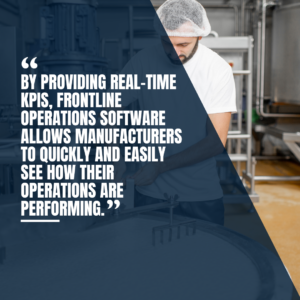Optimizing Operations: KPIs for Frontline Improvement
In the manufacturing industry, the ability to make quick and informed decisions can be the difference between success and failure. To accomplish this, it’s crucial to have access to real-time data and metrics that can help inform those decisions. Fortunately, frontline operations software provides a solution to this problem, allowing manufacturers to make informed decisions based on real-time KPIs instead of siloed data scraped together days, or even weeks after events. In this blog, we’ll break down frontline operations software, KPIs for frontline improvement and how it is designed to help businesses streamline efficiency. It does this by providing a centralized platform that allows manufacturers to monitor and manage their operations in real-time. This includes everything from tracking production levels to monitoring quality control, maintenance management, and more.
One of the key benefits of frontline operations software is its ability to provide real-time KPIs. KPIs, or key performance indicators, are metrics that are used to measure the success of an effort for improvement. They can be used to track everything from sales revenue to customer satisfaction, but in manufacturing, KPIs typically focus on factors like production levels, machine utilization, and defect rates. For an added benefit, manufacturing organizations are now integrating all types of financial and operations data for the use of profitability focused metrics. By providing real-time KPIs, frontline operations software allows manufacturers to quickly and easily assess how their operations are performing. This information can be used to make informed decisions about everything from production scheduling to machine maintenance. For example, if a manufacturer sees that a particular machine is underutilized, they can use that information to adjust their production schedule to maximize efficiency. Alternatively, if they notice a high defect rate, they can investigate the issue and take steps to improve quality control by performing a root-cause-analysis.
One of the main advantages of using frontline operations software to monitor KPIs is that it allows for a level of agility that would be impossible with traditional methods. In the past, manufacturers would need to rely on manual data entry and analysis, which could take hours or even days to complete. By the time the data was available, it may no longer be relevant. With frontline operations software, on the other hand, data is collected and analyzed in real-time, providing up-to-the-minute insights that can be used to make quick decisions for improvement. Of course, having access to real-time KPIs is only useful if manufacturers know how to interpret and act on that information. With analytical tools, manufacturers can drill down into their KPI data to uncover trends, identify problem areas, and make data-driven decisions. For example, if a manufacturer notices that a particular product line has a high defect rate, they can use analytics tools to determine which specific machines or processes are responsible for the issue by digging into the data. From there, they can take steps to address the problem, such as retraining employees or adjusting production processes.

Implementing frontline operations software and using real-time KPIs effectively involves a few key steps:
- Identify your Key Performance Indicators: Before implementing frontline operations software, it’s important to determine which KPIs you want to track. This will vary depending on your business goals and the nature of your manufacturing operations. Some common KPIs include production efficiency, machine utilization, and defect rates. Identify what KPIs are right for you, here.
- Choose the right software: There are many frontline operations software options on the market, so it’s important to choose one that meets your specific needs. Look for software that provides real-time data tracking and analytics capabilities, as well as a user-friendly interface.
- Attract & Train employees: Once you’ve selected your software, it’s important to train your employees on how to use it effectively. This may involve providing training sessions or creating user manuals to guide employees through the process.
- Set up alerts and notifications: Real-time data is only useful if you’re able to act on it quickly. Set up alerts and notifications within your frontline operations software so that you can be notified immediately when certain KPIs reach critical levels.
- Analyze your data: Finally, use your software’s analytics capabilities to drill down into your KPI data and identify trends, problem areas, and opportunities for improvement.
In addition to these steps, it’s important to regularly evaluate and update your KPIs to ensure that they remain relevant to your business goals. As your business evolves, your KPIs may need to change to reflect new priorities or challenges.
Implementing frontline operations software and real-time KPI tracking can be a game-changer for manufacturers. By providing quick and easy access to real-time data, businesses can make informed decisions that improve efficiency, increase production, and reduce costs. With the right software and training, frontline operations software and real-time KPIs can provide a significant competitive advantage in today’s fast-paced manufacturing industry.
In conclusion, frontline operations software and real-time KPIs are critical tools for manufacturers looking to optimize their operations and make data-driven decisions. By following these steps to implement and utilize these tools effectively, manufacturers can unlock a wealth of real-time data insights that can inform everything from production scheduling to process improvement. By investing in the right software and training, businesses can stay ahead of the competition and achieve long-term success in today’s competitive landscape.

